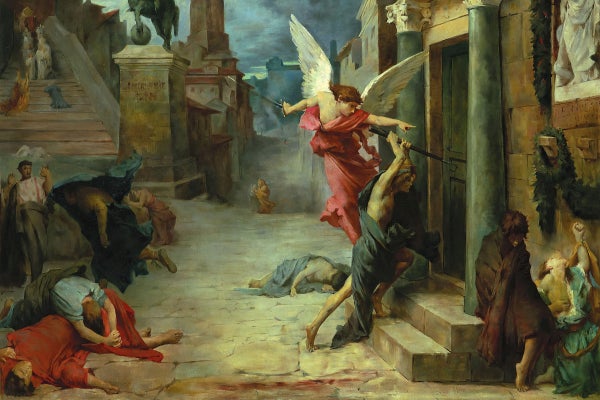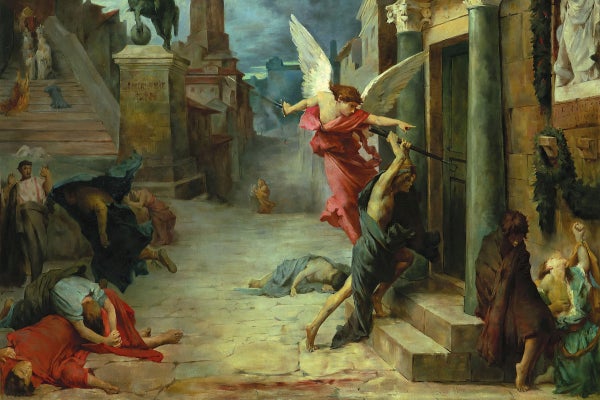January 26, 2024
4 min read
Changes in the climate may have caused disruptions to Roman society that manifested as disease outbreaks, researchers have found
By Tom Metcalfe

Jules Élie Delaunay’s “Plague in Rome” (1869)
The sixth-century C.E. Plague of Justinian was “a pestilence, by which the whole human race came near to being annihilated,” according to the Byzantine historian Procopius.
Up to half the population of the Roman Empire and tens of millions of people around the Mediterranean may have been killed in the pandemic, which is now known to have been an outbreak of bubonic plague. The disease typically started with a fever, followed by swellings in the groin and armpit, then a coma or delirium, then death. Nothing seemed to help: “in this disease there was no cause which came within the province of human reasoning,” Procopius wrote.
But a new study published on Friday in Science Advances links this—and other pandemics in the Roman Empire—to climate change. Specifically, it finds that periods of cold and dry weather on the Italian peninsula coincided with major plagues in the empire—indicating that the changes in climate caused stresses in Roman society that resulted in such pandemics. The match was so clear that “it was one of those times when, as a scientist, you go, ‘Wow,’” says study co-author Karin Zonneveld, a micropaleontologist at MARUM–Center for Marine Environmental Sciences at Germany’s University of Bremen.
The research—the culmination of a 10-year effort—shows how a changing climate can have dire consequences for societies that are not robust enough to withstand the upheavals it can cause, the study authors say. Those findings resonate today as the world contends with human-caused global warming.
There are few direct measurements of temperatures earlier than a couple hundred years ago, so scientists use indirect methods—called “proxies”—to peer back into Earth’s climate history. The proxies can include annual tree rings and layers of ice deposited over time on glaciers and polar caps. But no tree-ring studies yet show Italy’s climate during the Roman Empire, and most glaciers are in the Alps far to the north, which makes them unreliable for determining the climate farther south.
So Zonneveld and her colleagues turned to the next best record: fossilized shell-like cysts from microorganisms called dinoflagellates in seafloor sediments from Italy’s Gulf of Taranto. When the sea temperature decreased or increased, the species of dinoflagellates in the ancient seawater also changed, and the researchers could determine climate changes from the species’ distinctive cysts. By analyzing the fossils in different layers of the sediments, the team reconstructed the “paleoclimate” of southern Italy between about 200 B.C.E. and C.E. 600, with a resolution of roughly three years.
The reconstructions show that cooler periods—which had average temperatures as much as three degrees Celsius lower than the highs of preceding centuries for decades at a time—coincided with Roman reports of major pandemics: the Antonine Plague, from about C.E. 165 to 180; the Plague of Cyprian, from about C.E. 215 to 266; and a pandemic that began with the Plague of Justinian, from about C.E. 541 to 549, and ultimately lasted until C.E. 766.
Study co-author Kyle Harper, a historian at the University of Oklahoma and author of the book The Fate of Rome: Climate, Disease, and the End of an Empire, says the pandemics did not stem directly from the drop in temperature but seem to have resulted from disruptions caused by the changing climate in Roman society. These disruptions included declines in food supplies and the prevalence of rats, mosquitoes and other pests. “It’s not like cooling is bad per se,” he says. “It’s that when you have rapid climate change, it’s very destabilizing—it displaces ecosystems, and it destabilizes societies.”
Climate proxy records from other regions show the cold was global in that case, possibly the result of a series of massive volcanic eruptions. But the causes of the cold that coincided with the Antonine Plague and the Plague of Cyprian aren’t known. And the diseases behind those plagues are also unknown. Zonneveld says that natural climate oscillations may have been the culprit.
Historian John Haldon of Princeton University, who wasn’t involved in the latest research but studies the effects of climate change on history, says the study rightly notes the correlation between climate changes and disease outbreaks without stating they were directly related. He also says it is a good example of historians and scientists working together to interpret evidence of past events. “They can look at each other’s work and cross-check,” he says. “There’s a lot of verification that needs to be done.”
Seth Bernard, who studies ancient history at the University of Toronto and also wasn’t involved in the research, says it is relevant for modern responses to both climate change and disease pandemics.
But he says it is important to note that the Romans were living very close to their limit of food production, unlike many societies today. “They were creating a surplus when their economy was thriving, but the margins were very small,” Bernard says. As a result, when the climate changed, “very small changes in those margins could matter.”


